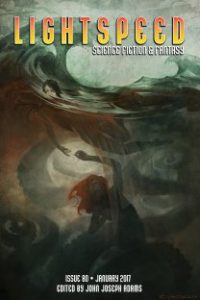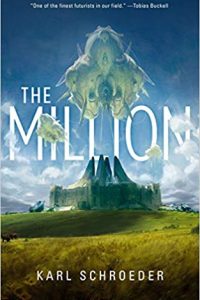Gardner Dozois reviews Short Fiction: August 2017
Lightspeed 1/17, 2/17, 3/17, 4/17, 5/17
Wired 1/17
 Online magazine Lightspeed got off to a bit of a weak start in 2017, with the reprint stories stronger than the original stories in both the January issue (reprints by James S.A. Corey and Mary Rosenblum) and the February issue (reprints by Ian R. MacLeod and Seanan McGuire), although there were solid but unexceptional stories such as “Nine-Tenths of the Law” by Molly Tanzer (January) and “The Last Garden” by Jack Skillingstead (February).
Online magazine Lightspeed got off to a bit of a weak start in 2017, with the reprint stories stronger than the original stories in both the January issue (reprints by James S.A. Corey and Mary Rosenblum) and the February issue (reprints by Ian R. MacLeod and Seanan McGuire), although there were solid but unexceptional stories such as “Nine-Tenths of the Law” by Molly Tanzer (January) and “The Last Garden” by Jack Skillingstead (February).
The March issue of Lightspeed was much stronger. The best story in March, and one of the best I’ve seen so far this year, was “The Wordless” by Indrapramit Das, which takes us to a distant planet which serves as a crossover point for interstellar ships. The story is told from the perspective of the pariahs who are allowed to run snack and souvenir booths for the tourists but who can never leave on one of the great shining ships themselves, and in particular from the point of view of a man who is so desperate for a new start for his family that he’s willing to try anything, no matter how insanely dangerous, to achieve it. [Editor’s note: The characters in this story are actually all agender.] Also good in March is “Soccer Fields and Frozen Lakes” by Greg Kurzawa, a dark, grim, brooding story about a man who is declared by the government to be not really human (a similar idea was explored in Robert Reed’s “Dunnage for the Soul” in the January/February F&SF), and the devastating effect this has on his family. I think this one could have used just a slice more backstory, as the father is classified as a “hybrid,” but we’re never told a hybrid of what; it’s also possible that the story would have been less unrelievedly grim if the author had stuck with either the government crackdown and oppression storyline or the lost children storyline, rather than trying to combine both at once. (I’m also bewildered as to why this is classified as “fantasy” – but then, the classifications in Lightspeed often puzzle me.)
The April Lightspeed is not as strong, but still features a good story about a woman searching across multiple timelines for a version of her daughter to replace the one she feels she’s lost, “Seven Permutations of My Daughter” by Lina Rather, and a story about a hospital worker who gets in trouble for trying to extend health-care services beyond the grave, “Remote Presence” by Susan Palwick.
With the May Lightspeed, we’re back to the reprint stories (by Tobias S. Buckell, Seanan McGuire, and Amal El-Mohtar) being stronger than even the best of the issue’s original stories, “This Is For You” by Bruce McAllister, which starts out as an interesting, somewhat YA-flavored story about a human boy who’d been raised on an alien planet trying to readjust to life in human society and take the first shy steps in courting a girl he likes – and then veers suddenly into horror, utilizing a gimmick that I found extremely unlikely.
For several years, the people behind MIT’s Technology Review magazine have been putting out an annual all-fiction issue, usually published as a separate chapbook. I haven’t seen one from them so far this year, but now Wired magazine has gotten into the act, with its January 2017 issue being dedicated as Wired: The Fiction Issue – Tales from an Uncertain Future. I can find no information on the Wired website as to who the editor of the issue is, although it may possibly be Robert Capps, who is listed on the masthead as Head of Editorial. Nor can I find any information as to how much it would cost to order just the January issue, without taking out a yearly subscription to the magazine, so you’re on your own there. Fortunately, all the stories are available on the Wired website, <www.wired.com>, so if you want to check them out but don’t necessarily want to take out an annual subscription, you can do so.
The issue consists almost exclusively of near-future stories that deal with the possibilities (or threats) of emerging technologies, much as do the MIT all-fiction issues. Also like the MIT volumes, there are some worthwhile stories here, although some of them come off as rushed and didactic – as though, having come up with an interesting future situation, the author didn’t want to bother with (or wasn’t given space to develop) an involving human story to tell in it. The best story here, by a good margin, is one in which the author did take the time to craft a compelling human story to go along with the futuristic speculation, “The Hunger After You’re Fed” by Daniel Abraham. This takes place in a small near-future Mexican village where an acolyte is obsessively trying to discover the true identity of – and ideally to meet – a famous radical writer who publishes only under an impenetrable pseudonym. There’s no reason why this couldn’t have been told as a mainstream story – a historical piece, perhaps, with the acolyte searching for the famously reclusive author B. Traven, who similarly kept his real identity secret – but the very clever details that Abraham works into the background about the benefits and disadvantages of a society where everyone is paid a guaranteed monthly income, and the way those strengths and weaknesses mirror the radical social theorizing of the anonymous writer the obsessed protagonist so admires, puts the story solidly into the ranks of the best of social science fiction. Also good here is “First” by John Rogers, an unusually sentimental piece for an anthology whose stories tend to slant toward the bleak and uncertain (as the title warned us), about how and why Martian colonists came to celebrate a peculiar historical anniversary. Also with several real human stories in it, “Know Your Enemy” by Matt Gallagher, is an entertaining bit of military SF, although it takes place a long way from the obvious battlefield. It’s about a group of cynical, disillusioned “war heroes” who are compelled to go on a bond drive, and the price each of them on the tour must pay for being trotted onstage and applauded every night as heroes.
Gardner Dozois was the editor of Asimov’s Science Fiction magazine for almost twenty years, and also edits the annual anthology series The Year’s Best Science Fiction, which has won the Locus Award for Best Anthology more than any other anthology series in history, and which is now up to its Thirty-Fourth Annual Collection. He’s won the Hugo Award fifteen times as the year’s Best Editor, won the Locus Award thirty-one times, including an unprecedented sixteen times in a row as Best Editor, and has won the Nebula Award twice, as well as a Sidewise Award, for his own short fiction, which has been most recently collected in When the Great Days Come. He is the author or editor of more than a hundred books, including a novel written in collaboration with George R.R. Martin and Daniel Abraham, Hunter’s Run, and, in addition to many solo anthologies, the anthologies, Songs of the Dying Earth, Warriors, Dangerous Women, and Rogues, all co-edited with George R.R. Martin, the last two of which were New York Times bestsellers. Coming up is a major solo fantasy anthology, The Book of Swords. He has been inducted into the Science Fiction Hall of Fame, and won the Skylark Award for Lifetime Achievement in Science Fiction. Born in Salem, Massachusetts, he now lives in Philadelphia, Pennsylvania.
This review and more like it in the August 2017 issue of Locus.




